#C. William O'Neill
Explore tagged Tumblr posts
Text
Ohio Governor DILFs





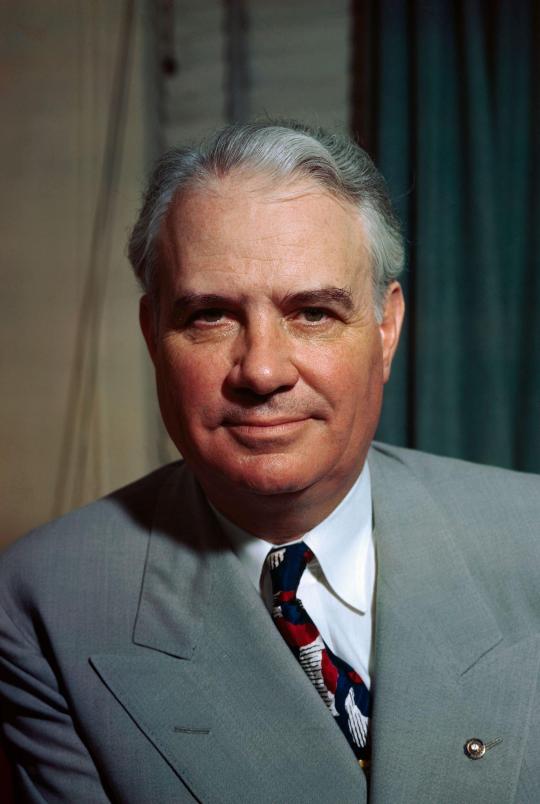



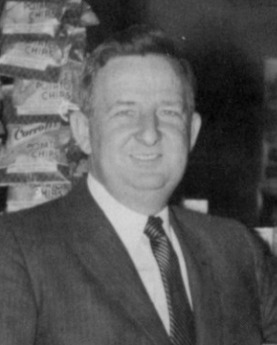


John Kasich, Ted Strickland, Mike DeWine, Jim Rhodes, Dick Celeste, John W. Bricker, John Gilligan, Michael DiSalle, Thomas J. Herbert, C. William O'Neill, Bob Taft, George Voinovich
#Ted Strickland#Mike DeWine#Jim Rhodes#John Kasich#Dick Celeste#John W. Bricker#John Gilligan#Michael DiSalle#Thomas J. Herbert#C. William O'Neill#Bob Taft#George Voinovich#GovernorDILFs
22 notes
·
View notes
Text
youtube
SEA OF LOVE (1989) Grade: C-
Overall silly and flippant film. It did remind me of #SoImarriedaxmurderer & now I want to know if mike Myers used this movie as a spring board. Hated the ending.
#Sea of Love#1989#C#Drama Films#Thriller Films#Murder#Cops#Police#Harold Becker#Serial Killer#Crime Films#Mystery Films#Romance Films#detective#Al Pacino#Ellen Barkin#Michael Rooker#John Goodman#William Hickey#Richard Jenkins#Gene Canfield#Paul Calderon#Larry Joshua#John Spencer#Barbara Baxley#Patricia Barry#Michael O'Neill#New York#Youtube
1 note
·
View note
Text
Making late Medieval Fringe
Fringe was an important part of 16th and 17th century Irish fashion. In this post, I will discuss the historical evidence for its use and my attempt to reconstruct it.
Fringe shows up on Irish garments in several period works of art.
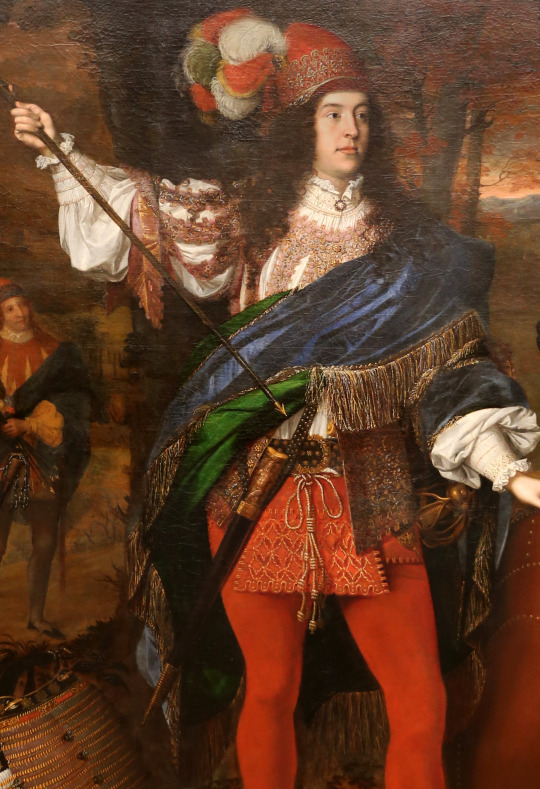
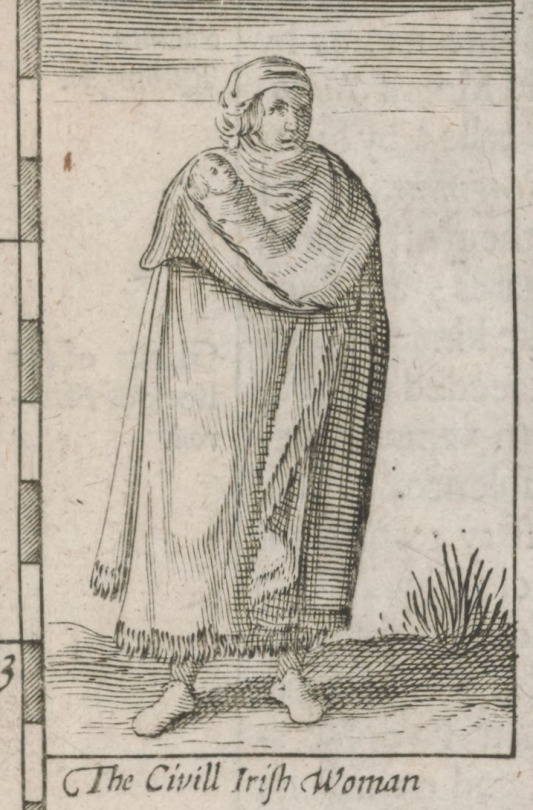
1680 Portrait of Sir Neil O'Neill by John Michael Wright and the 'Civill' Irish Woman from John Speed's 1611 map of Ireland, both shown wearing a fringed brat (Irish mantle).
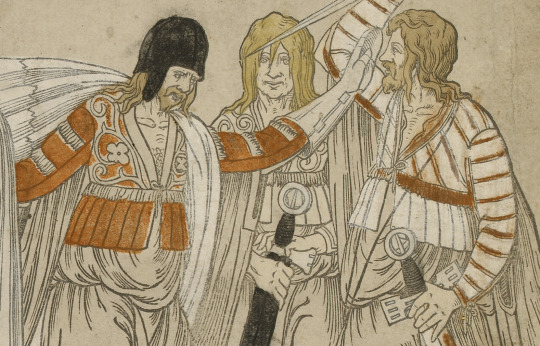
Detail from 'Drawn after the Quicke', an anonymous 16th c. English print showing Irish men wearing ionair (Irish short coats) embellished with fringe.
Historical Research:
The Irish use of fringe is mentioned by several period writers. In 1548, Paolo Giovio stated that most Irish men wore, "a soldier’s woollen cloak, with a fringed and variegated edge for elegance" (translation from Harris 2007). Similarly, William Good said Irish men and women wore "mantles or shag-rugs [. . .] fring'd round the edges with divers well mixt colours" (1586/1695). 17th century writers Luke Gernon (1620) and John Lynch (1661/1850) both described how the Irish continued to wear fringed mantles in spite of British colonial laws banning them. Gernon stated that the Irish mantle (ie brat) "differs nothing from a long cloke, but in the fringe at the upper end, which in could weather they [the Irish] weare over their heades for warmth," suggesting that this use of fringe was such an important part of Irish fashion that it was a marker of cultural identity.
This fringe appears to have been a separate trim, typically made of wool or silk, that was added to the garments. This is suggested by John Speed's description of Irish mantles as being "purfled with a deepe Fringe of divers colours" (1611). Applied fringe trim can be seen on the brat in Sir Neil O'Neill's portrait. In his poem "A Vision", 16th c. Irish poet Tadhg Dall Ó hUiginn describes a fairy woman wearing, "A purple mantle with satin fringes" (1550-1591/1921). Fringes made of silk and wool are found among recorded imports to Ireland in the late 16th c. (Flavin 2011).
Despite all this period evidence, I sadly do not know of any extant examples of Irish fringe from this period. Since at least some of the fringe used in Ireland was imported, I decided to look at examples from other parts of Europe to determine how Irish fringe might have been made. Looking at 15th-17th c. examples in the V&A, I saw 2 common manufacturing methods: warp-faced plain weave and tablet weave.
I decided to go with tablet weave for this project, because tablet woven bands have been found at earlier Medieval sites in Ireland (Wincott Heckett 2002). Following the historical costuming advice of The Welsh Viking that simple things less likely to be wrong, I used this simple late-15th c. fringe from Sweden as the basis for my pattern. Simple tablet-woven fringes continued to be used into the late 17th or early 18th century.
I used wool yarn for this project, because I wanted something that could have plausibly been made in Ireland and afforded by Irish commoners, instead of a luxury import like silk. Wool also seemed like the best fit for John Lynch's characterization of the fringe on a brat as a practical feature which protected the wearer's neck from the rain (1661/1850). I chose blue based on a combination of the availability of woad in 16th c. Ireland (Flavin 2011), the noted fondness of the Irish for bright colors (McClintock 1943), and personal preference.
My reconstruction:
I used Garnhuset wool weaving yarn I purchased from Vävstuga Weaving School in size 20/2 for the warp and 28/2 for the weft. (Check out this video, if you need an explanation of how tablet weaving works.) I made a box loom out of a cardboard box, although I suspect that any loom type that works for tablet weaving would also work for this.
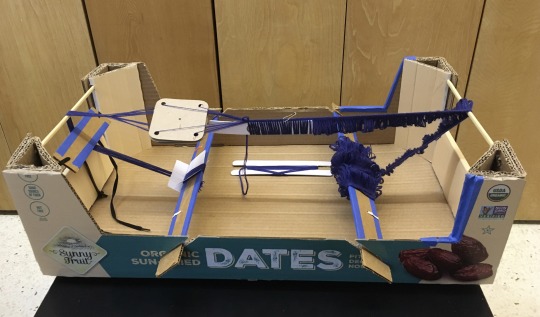
Also used bamboo chopsticks, tape to cover the rough edges of the cardboard, and a shoelace. Not pretty or historically accurate, but cheap and easy to make.
My tablet weaving pattern uses 6 cards. Cards 1,3,5 are Z threaded. Cards 2,4,6 are S threaded. All 6 cards are turned in the same direction until too much twist is built up on the warp to continue, all 6 cards are then turned in the opposite direction until too much twist is build up to continue. Reverse direction and repeat until you run out of warp.
For the weft, I used 5 strands the of 28/2 yarn run together as if they were a single weft thread. I placed a rectangle of sturdy cardboard against the left side of the warp and looped the weft around it as I wove. I neglected to get a good picture of this on my actual loom, so here is a picture of my test piece setup.

The relevant part here is the light blue and purple threads. Ignore the shuttle of black thread.
As I advanced the warp, I slid the cardboard rectangle forward to continue weaving. After I took the completed fringe off the loom, I took a pair of scissors and cut the bottoms of the weft loops.
If you try this, I strongly recommend covering the long edges of your cardboard rectangle with tape. This will both protect your warp from being chewed up the cardboard and make the cardboard more slippery and easier to to slide forward. Also, make sure you are beating the shed well and pulling your weft tight. Once you cut the loops, the tightness of your weave is the only thing keeping your fringe from pulling out.
Results:
I whipstitched the completed fringe to the edge of my brat. I am extremely happy with how this turned out. I had never done tablet weaving with wool before, so I had no idea what to expect.
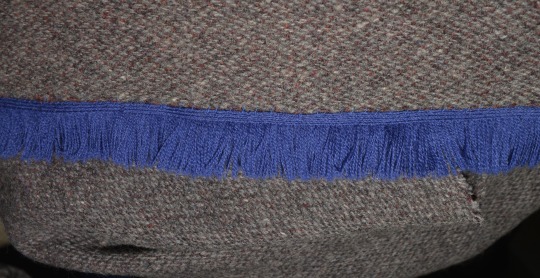
This method creates a thick, fluffy fringe which I think does a nice job recreating the look of "Drawn after the Quicke". You do lose quite a bit of length though. The wool yarn is kind of stretchy, and tablet weave is kind of stretchy (similarly to a twill-weave fabric). Between the ends of the warp lost to setting up the loom, and the stretchiness of the finished product, 11 ft (335 cm) of measured warp gave me 92 in (234 cm) of completed fringe. Oh, well. At least my loom can easily accommodate a longer warp, and this piece only used 20% of my 2 skeins of yarn.
I did also make a test piece out of DMC Pearl cotton. The warp is size 8 embroidery thread, and the weft is size 25 embroidery floss with all 6 strands used together. It is slightly easier to work with than the wool, (wool warps do have an annoying tendency to stick to each other), but I don't like the way it looks as much.

Wool fringe above, cotton below. Ignore the purple fringe. It has an extra weft thread that is not part of the fringe, which is why it looks more gappy than the light blue.
The cotton tends to stay in its discrete clumps rather than feathering out to form a nice fluffy, connected whole like the wool does.
I then went to the Ren Fair and located an appropriate sword.

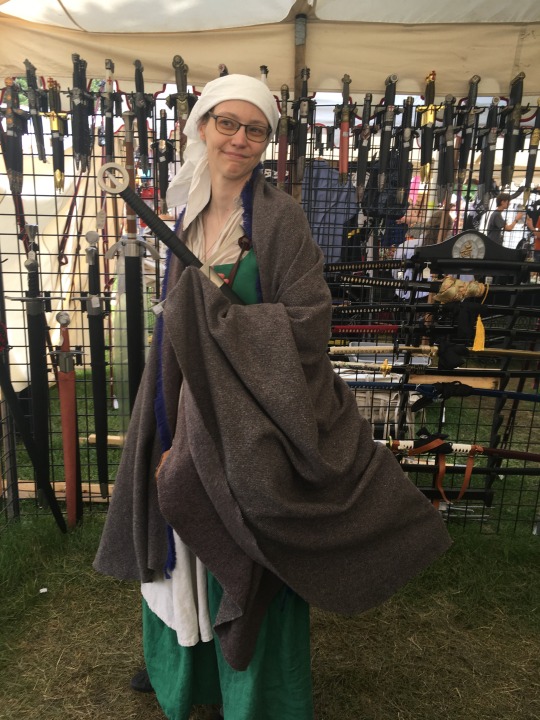
(Yes, that's an English kirtle and smock. I haven't finished making my other Irish garments yet.) Me carrying a sword a la Albrecht Dürer's kern.
I really should have made this fringe longer. It's only 1 in (2.5 cm) long. Looking at the scale of Speed's "Civill" woman, I would estimate that hers is closer to 2 inches long. I may add a longer second layer. John Lynch does say that the brat has a doubled layer of fringe in the neck area (1661/1850). Adding a second color to the weft would probably better match William Good's description of "divers well mixt colours" and Paolo Giovio's "variegated," but I like the way the solid blue looks.
As a bonus, I will say that the wool fringe feels softer and nicer than the cheap coating wool I used to make my brat. I suspect that may be part of the reason the 16th-17th c. Irish were so fond of having thick fringes in the neck area, to protect the skin of their necks from the irritation of a brat made of coarse wool. The léine would have protected most of their body, but it largely left the neck bare.
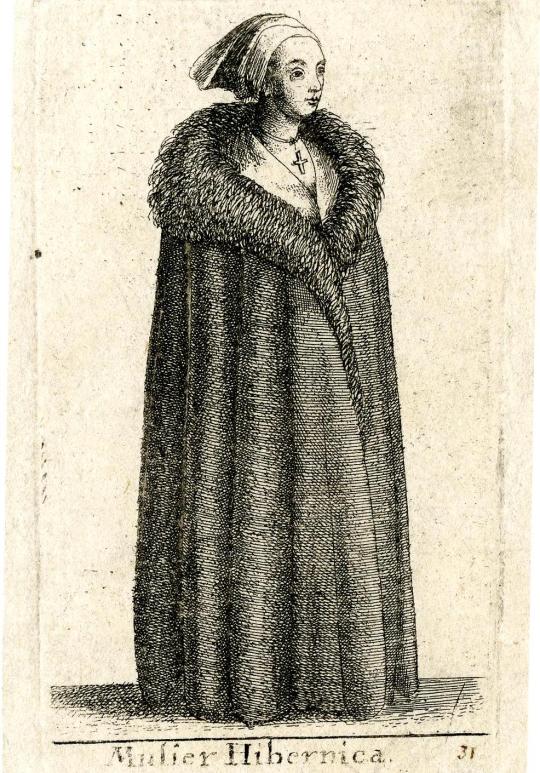
Irish woman wearing a brat with a deep fringe by Wenceslaus Hollar published 1643
Want to give me a tip? Ko-fi page
Bibliography:
Flavin, Susan (2011). Consumption and Material Culture in Sixteenth-Century Ireland. [Doctoral thesis]. University of Bristol.
Gernon, Luke (1620). A Discourse of Ireland. https://celt.ucc.ie/published/E620001/
Good, William (1695). The Ancient and Modern Customs of the Irish. In W. Camden (ed) Camden's Britannia newly translated into English, with large additions and improvements; publish'd by Edmund Gibson (p. 1042-1048) (Edmund Gibson, Trans.). Edmund Gibson. (Original work published 1586) http://name.umdl.umich.edu/B18452.0001.001
Harris, Jason (2007). Ireland in Europe: Paolo Giovio's "Descriptio" (1548). Irish Historical Studies, 35(139), 265-288.
Lynch, John. (1850). Cambrensis Eversus (Matthew Kelly, Trans.). Dublin: The Celtic society. (Original work published 1660) https://archive.org/details/cambrensisevers04kellgoog/page/200/mode/2up
McClintock, H. F. (1943). Old Irish and Highland Dress. Dundalgan Press, Dundalk.
Ó hUiginn, Tadhg Dall (1921). The bardic poems of Tadhg Dall Ó Huiginn (1550–1591) (Eleanor Knott, Trans.). (Original work published 1550-1591) https://celt.ucc.ie/published/T402563/index.html
Speed, John (1611). The Theatre of the Empire of Great Britaine: presenting an exact geography of the kingdomes of England, Scotland, Ireland, and the iles adioyning. William Hall, London.
Wincott Heckett, Elizabeth (2002). Irish Viking Age silks and their place in Hiberno-Norse Society. Textile Society of America Symposium Proceedings, 427. https://digitalcommons.unl.edu/tsaconf/427
#irish dress#16th century#17th century#irish history#historical men's fashion#historical women's fashion#historical costuming#dress history#fringe#irish mantle#bratanna#historical reconstruction
48 notes
·
View notes
Text
i just took my final ancient greek exam of the semester yesterday and have been avoiding studying for my microbiology exam all day. so let's talk about these three devastating lines from anne carson's translation of herakles

and by talk about i mostly mean here's a bunch of different translations

Ἡρακλῆς μαινόμενος - Herakles by Euripides, lines 1398-1400
c. 416 BC.
original text in Ancient Greek via the Perseus Digital Library
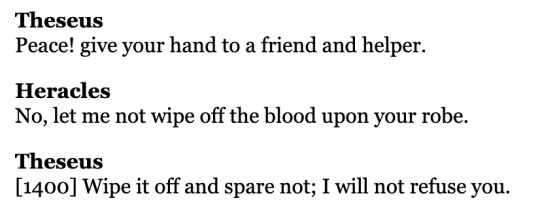
Euripides. The Complete Greek Drama, edited by Whitney J. Oates and Eugene O'Neill, Jr. in two volumes. 1. Heracles, translated by E. P. Coleridge. New York. Random House. 1938.


Herakles translated by Anne Carson in Grief Lessons: Four Plays by Euripides (pg 81-82) 2006
Internet Archive

H of H playbook by Anne Carson (not a direct translation but a reimagining of Herakles, 2021)

Euripides: Herakles, translated by Tom Sleigh, Oxford University Press, 2001
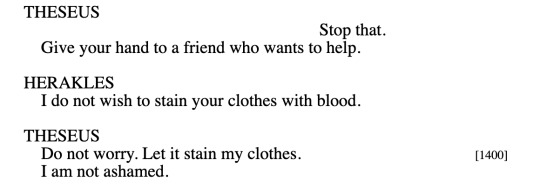
Ian C. Johnston, 2020
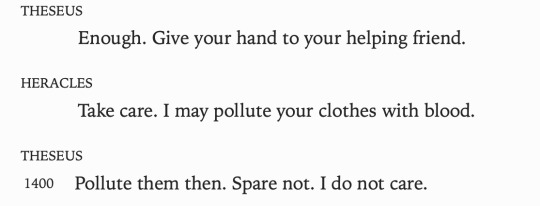
Heracles, translated by William Arrowsmith, from Euripides III: Heracles, the Trojan Women, Iphigenia Among the Taurians, Ion (The Complete Greek Tragedies - Euripides III, University of Chicago Press, 2013 (Arrowsmith's translation itself is from 1956)
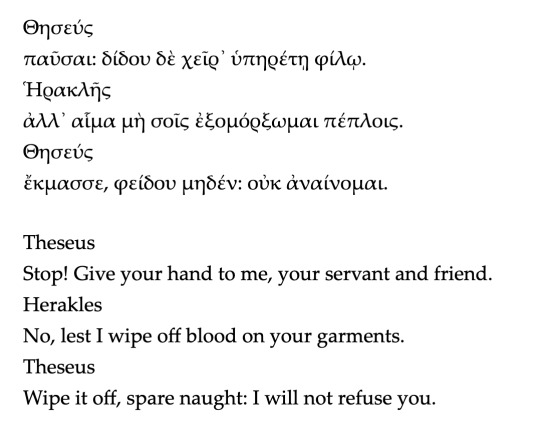
my own translation with notes under the cut
* everywhere that I have used [] I have inserted a word that does not technically appear in the original text.
Theseus Stop! Give [your] hand [to me], [your] servant [and] friend.
*more literally: Stop! Give [your] hand to a servant/helper [and] friend.
* Ancient Greek uses different punctuation, though the : symbol is used roughly the same way as it is in English and exclamation points are not used, verb conjugation in English does not differentiate the imperative mood, which παῦσαι (sg.2.aor.imperat.med-pass) is in, and often the way we show imperative mood in written English is with an exclamation point.
-The word δίδου (sg.2.praes.imperat.act.) is also imperative.
-παῦσαι is said in reference to Herakles’ earlier lines, lamenting his - well, the plot of Herakles.
* The particle δὲ has been omitted from the translation. It’s usually translated as but, and, or then.
* The possessive pronoun your - σός - does not appear but is implied.
* χεῖρ᾽ is the short version of χειρός - hand
* ὑπηρέτῃ φίλῳ are both nouns in dative, here answering the question to whom? The word and - καί - does not appear between the two, likely because poetic language. The word ὑπηρέτῃ can also mean rower, an underling, servant, attendant, assistant, and is often translated here as helper. The word φίλῳ is a form of φίλος - friend, loved, beloved, dear
Herakles No, lest I wipe off blood on your garments.
* Word order changed slightly. The first word is ἀλλ᾽ - poetically shortened version of ἀλλά - usually translated as but, however, here: lest.
* ἐξομόρξωμαι (sg.1.aor.med-pass.) means wipe off or wipe away, but stain is, in my opinion, not an inaccurate translation in regards to the meaning conveyed.
* πέπλοις means any woven cloth, here usually translated as garments, robes or clothes.
* αἷμα means blood and is grammatically either nominative or accusative, probably accusative, μὴ means not and σοῖς is a second person possessive pronoun in plural dative.
Theseus Wipe it off, spare naught: I [do] not refuse [you].
* ἔκμασσε (sg.2.praes.imperat.act.) - wipe it off - is imperative again, so is φείδου (sg.2.praes.imperat.med-pass.) - spare.
* μηδέν I translated as naught as in nothing, οὐκ means not
* ἀναίνομαι is in sg.1.praes.ind. - so present tense would be the most literal translation, ie. I do not refuse you, but the meaning might best be conveyed in English with the use of future tense, ie. I will not refuse you. The word can also mean reject, deny, renounce and disown, or be ashamed. Possible other translations: I don’t deny you; I won’t reject you; I am not ashamed; I won’t renounce you.)
That's all on Herakles, the rest is me rambling about Ancient Greek grammar for interested parties (mostly myself). If I could put a second cut here, I would.
Some further notes on the grammatical cases and verb conjugation. You'll have noticed that I've followed verbs with parentheses with some abbreviations. I'll break those down a little for those not in the know: unlike English, Ancient Greek has different endings to denote the person in verb conjugation - 1.sg being first person singular as in I, and so on with 2.sg - you, 3.sg he/she/singular they, 1.pl - we, 2.pl - plural you, 3.pl - plural they. There's also technically an extant dual form in some texts (when speaking of a pair of two) but it's rare. Ancient Greek conjugation also varies a lot by the temporal tense, the ancient greek times are present (praesens - praes.), future (futurum and futurum III), imperfect (imperfectum), strong and weak aorist (aor. - this one doesn't exist in any modern languages and is a bit of a jeremy bearimy but is usually translated as either present or past, depending on the context), perfect (perfectum), and pluperfect (pluscuamperfectum) - all of these except imperfect and pluperfect (which only have indicative forms) then have various forms - indicative (ind.), infinitive (inf.), imperative (imperat.), optative (opt.) and conjunctive (coni.). Verbs also have an active (act.) and middle and passive or active and mediopassive (med-pass.) form, except some verbs only have mediopassive versions and are thus translated as either active or mediopassive depending on the context. This is as complicated (and fun!) as it sounds. (editors note: the fun! was not sarcastic - i am a medstudent who hasn't had to take two semesters worth of classes on this, nor do i have to keep taking ancient greek next semester but i'm going to)
Nouns in Ancient Greek also have grammatical cases, nominative, genitive, dative, accusative and vocative, as do adjectives. They also have genders, and adjectives of course have positive, comparative and superlative (good, better, best) forms.
Ancient Greek also uses a lot of participles, which is like a noun-ified verb. Participles are also a concept in English, just - a lot simpler in English, and also I think in English a participle is a verb that has some characteristics of an adjective or noun, whereas in Ancient Greek participles and verbal adjectives are separate concepts. Participles are derived from verbs and have the same grammatical cases as nouns, nominative, genitive, dative, accusative and vocative, and singular and plural versions, and have three genders, masc., fem. and neut. - they also have active and mediopassive forms, and differ based on the temporal conjugation of the verb, retaining its augment, reduplication, characteristic added letters (for example σ in the future tense, and θη + σ in the passive future) or lack thereof, also they can have different endings or roots based on the tense. So, yeah, "conjugate and translate this verb in part.fut.pass.sg.masc.gen. and II aor.part.act.sg.acc.fem." is what a test question might look like at my level of studying ancient greek.
Sentence constructions also differ from English, some of the most common ones are AcI, NcI, genitivus absolutus. accusativus duplex and nominativus duplex. They also will often skip words (particularly the verb to be they often deemed unnecessary) and poetic language is its own can of worms with its own theoretical dialects and prosody.
All of this is like, barely scratching the surface, there's also a bunch of different dialects, stuff varies by era, all of the noun cases have like, a Bunch of different uses, and it's all terribly interesting.
#anne carson#should i do#not to me not if it's you#next?#ancient greek#ancient greece#philology#heracles#herakles#euripides#h of h playbook#grief lessons: four plays by euripides#web weaving
50 notes
·
View notes
Text
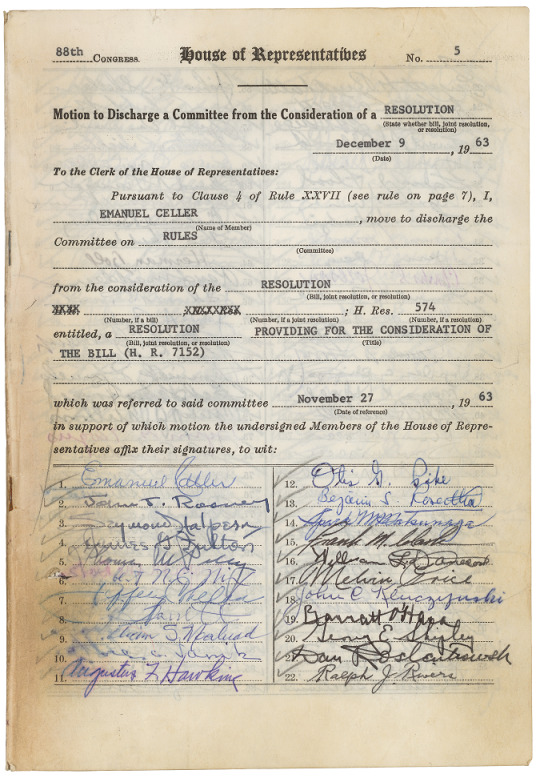
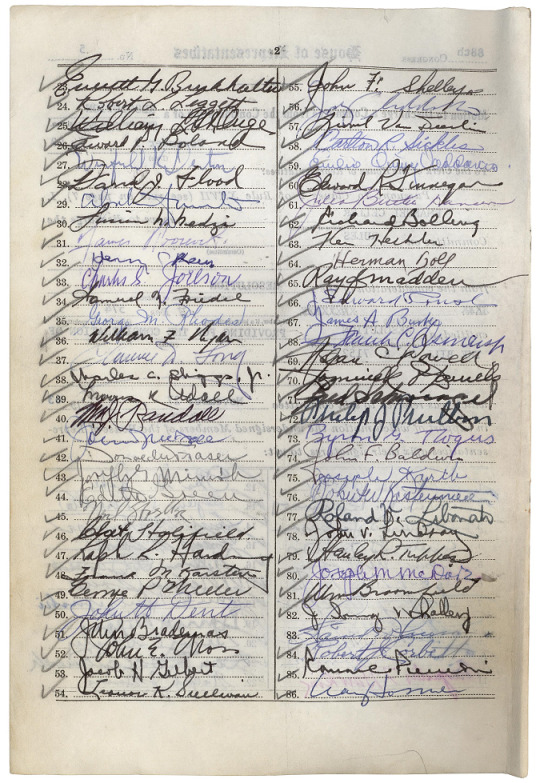
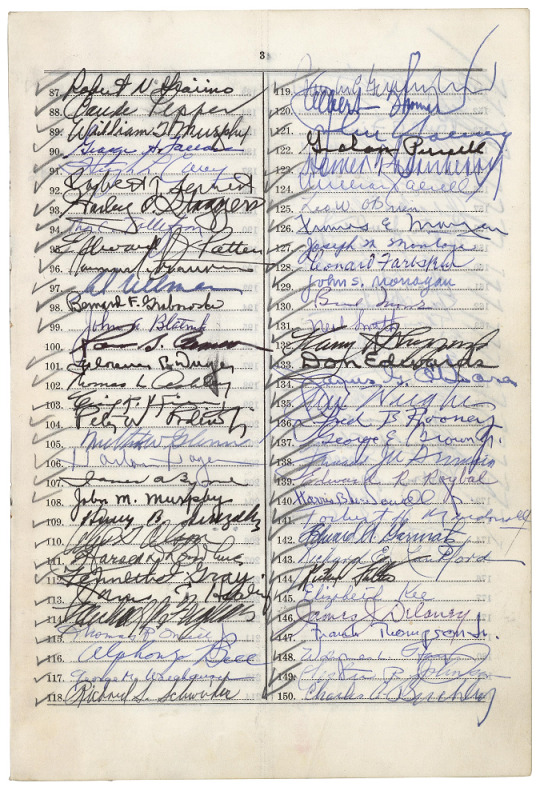

Discharge Petition for H.R. 7152, the Civil Rights Act of 1964
Record Group 233: Records of the U.S. House of RepresentativesSeries: General Records
This item, H.R. 7152, the Civil Rights Act of 1964, faced strong opposition in the House Rules Committee. Howard Smith, Chairman of the committee, refused to schedule hearings for the bill. Emanuel Celler, Chairman of the Judiciary Committee, attempted to use this discharge petition to move the bill out of committee without holding hearings. The petition failed to gain the required majority of Congress (218 signatures), but forced Chairman Smith to schedule hearings.
88th CONGRESS. House of Representatives No. 5 Motion to Discharge a Committee from the Consideration of a RESOLUTION (State whether bill, joint resolution, or resolution) December 9, 1963 To the Clerk of the House of Representatives: Pursuant to Clause 4 of Rule XXVII (see rule on page 7), I EMANUEL CELLER (Name of Member), move to discharge to the Commitee on RULES (Committee) from the consideration of the RESOLUTION; H. Res. 574 entitled, a RESOLUTION PROVIDING FOR THE CONSIDERATION OF THE BILL (H. R. 7152) which was referred to said committee November 27, 1963 in support of which motion the undersigned Members of the House of Representatives affix their signatures, to wit: 1. Emanuel Celler 2. John J. Rooney 3. Seymour Halpern 4. James G Fulton 5. Thomas W Pelly 6. Robt N. C. Nix 7. Jeffery Cohelan 8. W A Barrett 9. William S. Mailiard 10. 11. Augustus F. Hawkins 12. Otis G. Pike 13. Benjamin S Rosenthal 14. Spark M Matsunaga 15. Frank M. Clark 16. William L Dawson 17. Melvin Price 18. John C. Kluczynski 19. Barratt O'Hara 20. George E. Shipley 21. Dan Rostenkowski 22. Ralph J. Rivers[page] 2 23. Everett G. Burkhalter 24. Robert L. Leggett 25. William L St Onge 26. Edward P. Boland 27. Winfield K. Denton 28. David J. Flood 29. 30. Lucian N. Nedzi 31. James Roosevelt 32. Henry C Reuss 33. Charles S. Joelson 34. Samuel N. Friedel 35. George M. Rhodes 36. William F. Ryan 37. Clarence D. Long 38. Charles C. Diggs Jr 39. Morris K. Udall 40. Wm J. Randall 41. 42. Donald M. Fraser 43. Joseph G. Minish 44. Edith Green 45. Neil Staebler 46. 47. Ralph R. Harding 48. Frank M. Karsten 49. 50. John H. Dent 51. John Brademas 52. John E. Moss 53. Jacob H. Gilbert 54. Leonor K. Sullivan 55. John F. Shelley 56. 57. Lionel Van Deerlin 58. Carlton R. Sickles 59. 60. Edward R. Finnegan 61. Julia Butler Hansen 62. Richard Bolling 63. Ken Heckler 64. Herman Toll 65. Ray J Madden 66. J Edward Roush 67. James A. Burke 68. Frank C. Osmers Jr 69. Adam Powell 70. 71. Fred Schwengel 72. Philip J. Philiben 73. Byron G. Rogers 74. John F. Baldwin 75. Joseph Karth 76. 77. Roland V. Libonati 78. John V. Lindsay 79. Stanley R. Tupper 80. Joseph M. McDade 81. Wm Broomfield 82. 83. 84. Robert J Corbett 85. 86. Craig Hosmer87. Robert N. Giaimo 88. Claude Pepper 89. William T Murphy 90. George H. Fallon 91. Hugh L. Carey 92. Robert T. Secrest 93. Harley O. Staggers 94. Thor C. Tollefson 95. Edward J. Patten 96. 97. Al Ullman 98. Bernard F. Grabowski 99. John A. Blatnik 100. 101. Florence P. Dwyer 102. Thomas L. ? 103. 104. Peter W. Rodino 105. Milton W. Glenn 106. Harlan Hagen 107. James A. Byrne 108. John M. Murphy 109. Henry B. Gonzalez 110. Arnold Olson 111. Harold D Donahue 112. Kenneth J. Gray 113. James C. Healey 114. Michael A Feighan 115. Thomas R. O'Neill 116. Alphonzo Bell 117. George M. Wallhauser 118. Richard S. Schweiker 119. 120. Albert Thomas 121. 122. Graham Purcell 123. Homer Thornberry 124. 125. Leo W. O'Brien 126. Thomas E. Morgan 127. Joseph M. Montoya 128. Leonard Farbstein 129. John S. Monagan 130. Brad Morse 131. Neil Smith 132. Harry R. Sheppard 133. Don Edwards 134. James G. O'Hara 135. 136. Fred B. Rooney 137. George E. Brown Jr. 138. 139. Edward R. Roybal 140. Harris. B McDowell jr. 141. Torbert H. McDonall 142. Edward A. Garmatz 143. Richard E. Lankford 144. Richard Fulton 145. Elizabeth Kee 146. James J. Delaney 147. Frank Thompson Jr 148. 149. Lester R. Johnson 150. Charles A. Buckley4 151. Richard T. Hanna 152. James Corman 153. Paul A Fino 154. Harold M. Ryan 155. Martha W. Griffiths 156. Adam E. Konski 157. Chas W. Wilson 158. Michael J. Kewan 160. Alex Brooks 161. Clark W. Thompson 162. John D. Gringell [?] 163. Thomas P. Gill 164. Edna F. Kelly 165. Eugene J. Keogh 166 John. B. Duncan 167. Elmer J. Dolland 168. Joe Caul 169. Arnold Olsen 170. Monte B. Fascell [?] 171. [not deciphered] 172. J. Dulek 173. Joe W. [undeciphered] 174. J. J. Pickle [Numbers 175 through 214 are blank]
40 notes
·
View notes
Note
A-Z Challenge: List your sims in order, trying to complete the alphabet
I'm going to try this two ways. One for my TS3 stories (which have been sorely neglected lately and again for my TS4 stories)
A - Adam Van Vinkle (The Van Winkle Legacy - Gen 2))
B - Brian Van Winkle (The Van Winkle Legacy - Gen 2)
C - Clare Littlefield (The Van Winkle Legacy - Gen 2)
D - Donovan Glenn (NSQL - Gen 3)
E - Eddie Bennett (Not So Ordinary Life - Gen 1)
F - Faith Van Winkle (The Van Winkle Legacy - Gen 2)
G - Gene Bennett (Not So Ordinary Life - Gen 1)
H - Heath Van Winkle (The Van Winkle Legacy - Gen 3)
I - Isla Milton (NSQL - Gen 5)
J - Jean Van Winkle (The Van Winkle Legacy - Gen 1)
K - Kai Bennett (NSQL - Gen 5)
L - Luna Milton (NSQL - Gen 5)
M - Malachi Hale (The Van Winkle Legacy - Gen 4)
N - Noble Milton (Glitter - NSQL - Gen 4)
O - Oliver Milton (NSQL Gen 5)
P - Peter Van Winkle (The Van Winkle Legacy TS3)
Q - Quinn Syliva (The Van Winkle Legacy & Not So Ordinary Life)
R - Royce Marx (Glitter - NSQL Gen 4)
S - Sed Connelly (Glitter - NSQL Gen 4)
T - Trebor Bennett (Knights of Hope - NSRL Gen 4)
U - Unity Hollis (Glitter - NSQL Gen 4)
V - Verity Myles (NSRL - Gen 3)
W - William Bennett (Not So Ordinary Life TS3)
X -
Y -
Z - Zephyr Marx (NSQL - Gen 5)
TS4 - My Reagan Family Stories
A - Awan Bemossed, Addyson Kline, Ario Davison
B -
C - Cai'Ndrell Reagan, Cecil Reagan, Caleb Vatore
D - Dominick Reagan, Dicey Reagan, Dilly Reagan,
E - Evan/Ethan O'Neil, Eli Reagn, Ephriam Reagn, Ezekial Reagan
F -
G -
H - Halia Davison, Hunter Coates,
I - Izabel Walsh, Indy and Inara Kline, Isaac Reagan
J - Jackson Malloy, Jolene Reagan, Josie O'Neil, Jonah/Jayden Reagan, Jake Kline
K - Keenan Hartley
L - Liam Drake
M - Mandy Hinkle, McKenna Kline, Mathias
N -
O - Ocean Reagan
P -
Q -
R - Robin Fairchild,, Riley Reagan, Rory, Reagan, Ricky Reagan, Remy Reagan, Raelyn Reagan, Rachel Reagan, Ryan Anderson
S - Shiloh Hennessey, Sage Hennessey
T - Titus Queen, Tony Keeling
U -
V -
W -
X - Xander Eldridge
Y -
Z - Zara Drake
Thanks for the tag. I know I probably missed a lot and some I skipped because they were all the same letters I already had especially for my TS4 characters.
4 notes
·
View notes
Text
What is CANSLIM method in Indian stock market?
The CANSLIM method is a popular stock selection strategy developed by William O'Neil, founder of Investor's Business Daily. This method is widely applied in global markets, including India, to identify high-growth stocks with strong potential for long-term gains. CANSLIM is an acronym that represents seven key criteria used to evaluate stocks. Here’s a breakdown of the method as it applies to the Indian stock market:
C - Current Earnings Growth:
Look for companies with a high quarterly earnings growth rate (usually above 25% year-over-year) as a sign of financial strength. In India, strong earnings growth can indicate resilience in a company amid fluctuating economic conditions.
A - Annual Earnings Growth:
Annual earnings should ideally grow by at least 25% over the last three to five years. This long-term growth indicates consistency and helps differentiate solid companies from those with temporary gains.
N - New Product, Service, or Management:
Companies launching innovative products or services, entering new markets, or led by effective management often outperform. In India, sectors like technology, finance, and consumer goods regularly see innovation, making them ideal for CANSLIM.
S - Supply and Demand:
Stocks with lower supply (fewer shares available) and high demand typically have higher potential for price increases. In India, high promoter stakes and low float can create such conditions, particularly in niche companies or emerging sectors.
L - Leader or Laggard:
Choose sector leaders over laggards, as they usually have strong financials, established market share, and brand recognition. Investors in the Indian market may favor blue-chip stocks or leaders within specific sectors.
I - Institutional Sponsorship:
Institutional investment in a company is often a positive sign, reflecting the confidence of large investors. In India, stocks with backing from mutual funds, insurance companies, or foreign institutional investors (FIIs) tend to be more stable.
M - Market Direction:
Invest when the overall market is trending upwards. In India, tracking major indices like the NIFTY 50 or SENSEX can indicate market health. The CANSLIM approach emphasizes that it's better to avoid investments during a bear market phase.
CANSLIM in Practice
The CANSLIM approach is more suited to growth stocks rather than value stocks. Investors in India using this strategy often focus on mid-cap and large-cap stocks with a high growth potential, such as those in sectors like IT, financials, and consumer goods, which have demonstrated strong earnings potential. It requires technical and fundamental analysis, making it ideal for investors willing to stay engaged with market trends.

#growth stocks#share market#stocks#indian stock market#breakout stocks#canslim#investments#market outlook#stocks to buy#stock market#bse#nse#financetips#investing#invest#investors#personal finance
5 notes
·
View notes
Text
All the books I read in 2024 (in reverse chronological order)
Vacation by Deb Olin Unferth
A Local Hbitatation (October Daye #2) by Seanan McGuire
Summer Sons by Lee Mandelo
The Stardust Grail by Yume Kitasei
Winter Spirits short story collection
The Agatha Christie Book Club #1 by C A Larmer
The Haunting of Hill House by Shirley Jackson
Retour à St Mary (Cosy Christmas Mystery #1) by Carine Pitocchi
Le Père Porcher (Chroniques du Disque-Monde #20) by Terry Pratchett
Soie by Alessandro Baricco
Prince Caspian (The Chronicles of Narnia #2) by C S Lewis
A Day of Fallen Night (Root of Chaos #0) by Samantha Shannon
Alias Grace by Margaret Atwood
When Among Crows by Veronica Roth
My Roommate is a Vampire by Jenna Levine
Somewhere Beyond the Sea (Cerulean #2) T J Klune
The Sword Catcher (Chronicles of Castelane #1) by Cassandra Clare
La Dame du manoir de Wildfell Hall (The Tenant of Wildfell Hall) by Anne Brontë
L'amant by Marguerite Duras
The Restaurang at the End of the Universe (Hitchhiker's Guide to the Galaxy #2) by Douglas Adams
Une belle vie by Virginie Grimaldi
Dracula by Bram Stoker
Wintersmith (Discworld #34) by Terry Pratchett
Everyone In My Family Has Killed Someone (Ernest Cunningham #1) by Benjamin Stevenson
What Feast at Night (Sworn Soldier #2) by T Kingfisher
Le Bastion des Larmes by Abdellah Taïa
If We Were Villains by M L Rio
War and Peace by Leon Tolstoi
The Kaiju Preservation Society by John Scalzi
Rule of Two (Darth Bane Trilogy #2) by Drew Karpyshyn
Les Dragons by Jérôme Colin
Hotel Magnifique by Emily J Taylor
Le dieu d'automne et d'hiver by Pauline Sidre
Les Possibles by Virginie Grimaldi
A Close and Common Orbit (Wayfarer #2) by Becky Chambers
The Outsider by Stephen King
Once and Future Witches by Alix E Harrow
Tous les silence ne font pas le même bruit by Baptiste Beaulieu
Trois battements un silence by Anne Fakhouri
Kiss Kiss by Roal Dahl
Assassin's Apprentice (Realm of the Elderlings #1) by Robin Hobb
Halloween Party by Agatha Christie
Artificial Condition (Murderbot Diary #2) by Martha Wells
The Light Throught the Leaves by Glendy Vanderah
Et que ne durent que les moments doux by Virginie Grimaldi
The Eyes are the Best Part by Monika Kim
Ring Shout by P Djeli Clark
The Rest of the Robots (Robots #2) by Isaac Asimov
Wuthering Heights by Emily Brontë
On the Way to the Wedding (Bridgerton #8) by Julia Quinn
Our Missing Heart by Celeste Ng
Book of Blood I by Clive Barker
Ilos by Marion Brunet
Babel by R F Kuang
Rosemary and Rue (October Daye #1) by Seanan McGuire
Thud! (Discworld #34) by Terry Pratchett
Sea of Tranquility by Emily St John Mandel
Les aventures de Billy et du Pyrobarbare : la forteresse du chaudron noir by Bob Lennon
Space Opera by Catherynne M Valente
Magie et Sentiments : les secrets de Longdawn by Ariel Holzl
A Confederacy of Dunces by John Kennedy Toole
It's in His Kiss (Brigerton #7) by Julia Quinn
Les Cinq by Matthieu RochelleDid You Hear About Kitty Karr by Crystal Paul Smith
The Lion the Witch and the Wardrobe (The Chronicles of Narnia #1) by C S Lewis
How to Raise a Kraken in Your Bathtub by P Djeli Clark
An Appointment with Death by Agatha Christie
The Oleander Sword (The Burning Kingdoms #2) by Tasha Suri
Time to Orbit : Unknown by Derin Edala
It's Kind of a Funny Story by Ned Vizzini
4.48 Psychosis by Sarah Kane
Under the Whispering Door by T J Klune
The Moth Keeper by Kay O'Neill
Cain's Jawbone by E Powys Mathers
Darth Bane : Path of Destruction (Darth Bane #1) by Drew Karpyshyn
Du thé pour les fantômes by Chris Vuklisevic
Labyrinthes (Caleb Tracksman #3) by Franck Thiliez
The Long Way to a Small Angry Planet (Wayfarers #1) by Becky Chambers
Le dernier des siens by Sibylle Grimbert
Five Little Pigs by Agatha Christie
Going Postal (Discworld #33) by Terry Pratchett
House of Hollow by Krystal Sutherland
Blanche-Neige et les lances-missiles (Du temps où les dieux buvaient #1) by Catherine Dufour
When He Was Wicked (Bridgerton #6) by Julia Quinn
The Lord of the Flies by William Golding
Celle qu'il attendait by Baptiste Beaulieu
Jusqu'à ce que mort s'ensuive by Olivier Rolin
American Gods by Neil Gaiman
The Song of Achilles by Madeline Miller
The Umbrella Academy Vol 1-3 by Gerard Way and Gabriel Bà
Il était deux fois (Caleb Tracksman #2) by Franck Thilliez
Camp Damascus by Chuck Tingle
To Sir Phillip With Love (Bridgerton #5) by Julia Quinn
Le papillon des étoiles by Bernard Werber
Beren and Luthien by J R R Tolkien
A Hat Full of Sky (Discworld #32) by Terry Pratchett
Le manuscrit inachevé (Caleb Tracksman #1) by Franck Thiliez
The Murder of Roger Ackroyd by Agatha Christie
Akata Witch (Akata Witch #1) by Nnedi Okorafor
Romancing Mr Bridgerton (Bridgerton #4) by Julia Quinn
The Devil and the Dark Water by Stuart Turton
An Offer from a Gentleman (Bridgerton #3) by Julia Quinn
Delicious in Dungeon vol 1-14 by Ryoko Kui
Doctor Who : the Star Beast by Gary Russell
La promesse de l'aube by Romain Gary
The Jasmine Throne (The Burning Kingdoms #1) by Tasha Suri
The Hitchhiker's Guide to the Galaxy by Douglas Adam
The Illiad by Homer (trad Emily Wilson)
The Viscount Who Loved Me (Bridgerton #2) by Julia Quinn
The Me You Love in the Dark by Scotty Young
The Duke and I (Bridgerton #1) by Julia Quinn
Murder at the Vicarage by Agatha Christie
Nona the Ninth (Locked Tomb #3) by Tamsyn Muir
The Catcher in the Rye by J D Salinger
House of Leaves by Mark Z Danielewski
The House in the Cerulean Sea by T J Klune
I, Robot (Robot #1) by Isaac Asimov
Monstrous Regiment (Discworld #31) by Terry Pratchett
The Faceless Old Woman Who Secretly Lives in your Home by Jeffrey Cranor and Joseph Fink
Fullmetal Alchemist Vol 1-27 by Hiromu Arakawa
The Remarkable Retirement of Edna Fischer by E M Anderson
All System Red (Murderbot Diaries #1) by Martha Wells
Veiller sur elle by Jean-Baptiste Andrea
Julius Caesar by William Shakespeare
Segurant le chevalier au dragon by Emanuele Arioli
Chanson Douce by Leila Sleimane
The Picture of Dorian Gray by Oscar Wilde
He Who Drowned The World (The Radiant Emperor #2) by Shelley Parker Chan
Et à la fin ils meurent by Lou Lubie
Flowers for Algernon by Daniel Keyes
Coraline by Neil Gaiman
The Wee Free Men (Discworld #30) by Terry Pratchett
Fourth Wing by Rebecca Yarros
Harrow the Ninth (Locked Tomb #2) by Tamsyn Muir
Histoire de coming out by Baptiste Beaulieu and Sophie Nanteuil
Heartstopper Vol 1-4 by Alice Oseman
The Old Guard by Greg Rucka
The Seven Deaths of Evelyn Hardcastle by Stuart Turton
Le Comte de Monte-Cristo by Alexandre Dumas
La Cicatrice by Bruce Lowrey
Farenheit 451 by Ray Bradbury
Us by Sara Soler
Gideon the Ninth (Locked Tomb #1) by Tamsyn Muir
0 notes
Text
Thank you to Halla Rempt, Aaron J. Seigo, Adam Celarek, Adam Pigg, Adriaan de Groot, Adrian Page, Adrian Schroeter, Albert Astals Cid, Alberto Villa, Alexander Neundorf, Alexander Potashev, Alexis Ménard, Alfredo Beaumont Sainz, Allen Winter, Alvin Wong, Ana Beatriz Guerrero López, Andras Mantia, Andreas Hartmetz, Andreas Lundin, André Marcelo Alvarenga, Andrew Coles, Andre Woebbeking, Andrius da Costa Ribas, Andy Fawcett, Anne-Marie Mahfouf, Ariya Hidayat, Arjen Hiemstra, Bart Coppens, Ben Cooksley, Benjamin K. Stuhl, Benjamin Meyer, Benjamin Reed, Benoît Jacob, Ben Schleimer, Bernhard Rosenkraenzer, Bo Thorsen, Brad Hards, Bram Schoenmakers, Burkhard Lück, Carlo Segato, Carsten Hartenfels, C. Boemann, Christer Stenbrenden, Christian Ehrlicher, Christian Mueller, Christoph Feck, Chusslove Illich, Clarence Dang, Cyrille Berger, Daniel M. Duley, Daniel Molkentin, Dan Leinir Turthra Jensen, Dan Meltzer, Danny Allen, David Faure, David Gowers, Demetry Romanowski, Dirk Mueller, Dirk Schönberger, Dmitry Kazakov, Edward Apap, Elvis Stansvik, Emanuele Tamponi, Emmet O'Neill, Enrique Matías Sánchez, Eoin O'Neill, Fabian Kosmale, Frank Osterfeld, Frederik Schwarzer, Fredrik Edemar, Fredy Yanardi, Friedrich W. H. Kossebau, Gábor Lehel, Gary Cramblitt, Geoffry Song, Gioele Barabucci, Giovanni Venturi, Gopalakrishna Bhat A, Hanna Scott, Harald Sitter, Hasso Tepper, Helge Deller, Helio Castro, Hideki Saito, Hoàng Đức Hiếu, Hugo Pereira Da Costa, Inge Wallin, Ingo Klöcker, İsmail Dönmez, Ivan Yossi, Jaime, Jaime Torres, Jaison Lee, Jakob Petsovits, Jakub Stachowski, Jan Hambrecht, Jarosław Staniek, Jens Herden, Jessica Hall, Johannes Simon, John Layt, Jonathan Riddell, Jonathan Singer, José Luis Vergara, Juan Luis Boya García, Juan Palacios, Jure Repinc, Kai-Uwe Behrmann, Karl Ove Hufthammer, Kevin Krammer, Kevin Ottens, Kurt Pfeifle, Laurent Montel, Lauri Watts, L. E. Segovia, Leo Savernik, Lukáš Tinkl, Lukáš Tvrdý, Maciej Mrozowski, Malcolm Hunter, Manuel Riecke, manu tortosa, Marc Pegon, Marijn Kruisselbrink, Martin Ellis, Martin Gräßlin, Matthew Woehlke, Matthias Klumpp, Matthias Kretz, Matus Talcik, Maximiliano Curia, Melchior Franz, Michael David Howell, Michael Drueing, Michael Thaler, Michel Hermier, Mohit Goyal, Mojtaba Shahi Senobari, Montel Laurent, Moritz Molch, Nabil Maghfur Usman, Nick Shaforostoff, Nicolas Goutte, Olivier Goffart, Patrick Julien, Patrick Spendrin, Pavel Belskiy, Pavel Heimlich, Peter Simonsson, Pierre Ducroquet, Pierre Stirnweiss, Pino Toscano, Rafael Fernández López, Raphael Langerhorst, Rex Dieter, Rob Buis, Roopesh Chander, Sahil Nagpal, Salil Kapur, Samuel Buttigieg, Sander Koning, Sascha Suelzer, Scott Petrovic, Scott Wheeler, Sebastian Sauer, Shivaraman Aiyer, Siddharth Sharma, Silvio Heinrich, Somsubhra Bairi, Spencer Brown, Srikanth Tiyyagura, Stefan Nikolaus, Stephan Binner, Stephan Kulow, Stuart Dickson, Sune Vuorela, Sven Langkamp, Thiago Macieira, Thomas Capricelli, Thomas Friedrichsmeier, Thomas Klausner, Thomas Nagy, Thomas Zander, Thorsten Staerk, Thorsten Zachmann, Tim Beaulen, Timothée Giet, Tobias Koenig, Tom Burdick, Torio Mlshi, Torsten Rahn, Unai Garro, Urs Wolfer, Vadim Zhukov, Vera Lukman, Victor Lafon, Victor Wåhlström, Volker Krause, Waldo Bastian, Werner Trobin, Wilco Greven, Will Entriken, William Steidtmann, Wolthera van Hovell, Yann Bodson, Yue Liu and Yuri Chornoivan.
Really
0 notes
Text
Birthdays 10.16
Beer Birthdays
Santiago Graf (1845)
Five Favorite Birthdays
Bob Mould; rock guitarist, singer (1960)
Eugene O'Neill; playwright (1888)
Tim Robbins; actor (1958)
Noah Webster; lexicographer (1758)
Oscar Wilde; Irish writer (1854)
Famous Birthdays
Sue Bird; basketball player (1980)
Arnold Böcklin; Swiss artist (1827)
Rembrandt Bugatti; sculptor (1884)
Michael Collins; Irish activist (1890)
Barry Corbin; actor (1940)
Linda Darnell; actor (1924)
William O. Douglas; U.S. Supreme Court justice (1898)
Flea; rock bassist (1962)
Adrianne Frost; comedian (1972)
Goose Goslin; Washington Senators LF (1900)
Gunter Grass; German writer (1927)
Bert Kaempfert; musician (1923)
Angela Lansbury; actor (1925)
Melissa Lauren; French porn actor (1984)
John Mayer; pop singer (1977)
Tim McCarver; St. Louis Cardinals C (1941)
Nico; German model, singer (1938)
Benjamin Russell; artist (1804)
Suzanne Somers; actor (1946)
Paul Strand; photographer (1890)
C.F. Turner; rock musician (1943)
Albrecht von Haller; Swiss anatomist, physiologist, naturalist (1708)
Bob Weir; rock singer, guitarist (1947)
Wendy Wilson; pop singer (1969)
David Zucker; film director (1947)
1 note
·
View note
Text

"NIKE, Inc. is a team comprised of the Nike, Jordan and Converse brands driven by a shared purpose to leave an enduring impact."
—
World's Most Valuable Sports Brand: Nike
Air Jordan is undoubtedly one of Nike's most successful and iconic brands.
—
1984 - 2024
40 years of Air Jordan.
—
2024 Nike, Inc. Executive Officers
1. Philip Knight - Chairman Emeritus, Co-founder
2. Mark Parker
3. John Donahoe
4. Thomas Clarke
5. Matthew Friend
6. Monique Matheson
7. Ann Miller
8. Muge Dogan
9. Heidi O'Neill
10. KeJuan Wilkins
11. Craig Williams
THE CHAMP : KINETIC MICHAEL JORDAN
T • Thomas Clarke
C • Craig Williams
H • Heidi O'Neill
A • Ann Miller
M • Mark Parker
M • Matthew Friend
M • Monique Matheson
P • Philip Knight
K • KeJuan Wilkins
M • Muge Dogan
J • John Donahoe
—
Photo credit:
Nike, Inc.
—
#KineticGOAT
0 notes
Text
Agency Career (CIA Field Agent, Raised Since Birth; 1985-2024)
1989: Drop of Berlin Wall, informed tip to Holy See on Rabbi Anatole; vice and collegiate draft, of athletes wife. Polish Jewish labor mills, Gentile produced pork; isolated Israeli produce, to Arabia.
1992: Removal of amphetamines from children's medicine, IQ test revealed passage on State Police Captain's examination at maximum level; other child, converted Converso, allowed to return as Judaism; end of Sino-Judaic movement, Egyptian.
1996: Informed tip on Andrew Wachowski, Carrie-Anne Moss, and Raven Laventi, for enslavement of dominatrixes, preferred wives of Garfield Lodge rules, however as submissives, as if common prostitutes; rule reformed, 1860s, President James Garfield, Battle of Shiloh; wars won, Vicksburg, and Wilderness.
1999: Murder of Alice C. O'Neill, claimed named Charlebois, for Colombian betrayal into Likud, past war advisors of Chinese enemy; signals of CVS German-Israel alliance with PRCC-Diet, Japanese South Korean transit. Dragonball produced, at siding with North Korea, and the People's Republic of Communist China. Future trade partners, under George W. Bush, "Joshua Tree".
2003: Yeltsin revealed through Hopkinton, Massachusetts, as center basin of school shootings, beginning in 1990s; Holocaust History Museum, disapproval of temporary lesbianism, for shame of being Holocaust victims; German-Israel revealed as being the prime conspiracy, Israelis thrown out of orders as Wehrmacht. Rise of George Soros, Romalian, having had a precognitive accident, on motorway, dueling Mossad.
2004: Revealing of External Security pimping scandal, through Hamas; beginning of mathematical frequency, planted by Wiccans, Confederate-Catholics, to reform with African and Asian communities. Spanish pimping, "Ali", Episcopal drafts, "Popeye", Irish cops, "Blintzen", German spies, "Schnitzel", and remaining endeavors, Russian factories, "Google", African voudoun, "Mosey", and British fascist, "Mandatory".
2006: Sheriff's Cajun, of Fugitive Slave Act, removed through frame of Marvel Comics, under auspice of Hell's Angels; Third Degree interrogation, of Lairds of gender therapy, the mating of wives to unusual genomes of logic. Shut down, by lesbian accusations, the combined Kampuchean logic of all tribals associated, having been declared as poorly invertebrate. Friends Stand United, contacted, for Hollywood hit; the Foreign Office, readmission to destiny. The CIA's blessing, given, to learn new lessons.
2010: Suicide Squad on print; dietary disorders, of major operatives, offered as medicine and pills; except for Captain Boomerang, tomato sauce, potentially deadly kill ratio; "Vile", "Vava"; Doctor Ciel Mallory, Alice O'Neill.
2013: Murder of Whitey Bulger, for releasing secret that the Beatles, was anti-British, and that homosexual children steal brides, through the "Beatles", on forged check proxy of self, on strike to head; with lesbians, allowed to marry, however caged and hazed and brutally murdered, if a fan of American music of British recording studio print.
2016: Separation of factory unions, white supremacists, ordered, for African civil rights, blacks being the foundational bedrock of community, opposed to Asians; simpleton little people, working in small factories, without any ability to express own face. Racial inferiors, compared to Africans; Africans incapable of murder, Asians incapable of yielding. John Rocker.
2020: Mass quandry quarry, of INTERPOL, Unitarians, Tong, MI-6, and Abwehr, as Art Bell subscribers, held in prison facilities apart from wives and children; children turned over to CIA indentures, as orphans, to become proper Americans, as State Police Colonels; any dissenting, ignored by news, their supporting journalists indemnified, by Mayor Wu, of Boston.
2024: Gay leaders outed, as George W. Bush, Kim Jong-un, and Crown Prince William; having claimed own condition, is the other, the inability to produce a child, instead adopting under false claim; German-Mormon.
0 notes
Text
Jesus here's my May birthdays edit for those who passed away and Madeleine McCann who went missing in 2007 at 3 years old Vera S. Barton, Amerie Jo Garza, Maranda Gail Mathis, Merka Ulmann Barkan, Abram Aba Barkan, Helen B. Antin, Szyfra “Stefi” Fiszbaum Altman, Hershel “Harry” Altman, Francie Waligora Alpert, Anne V. Berend Allen, Reghina Gottesman Adler, Ludwig “Lou” Adler, My grandma Margaret Downs, Erna “Edna” Grunebaum Adler, Judith Kallus Abrahamer, Otto Heinrich Frank, Hana Brady, Bob Saget, Gianna Maria-Onore Bryant, Bojana Asović, John F. Kennedy, Kyle Albert Velasquez, Joanna Caroline “JoJo” Ross, Kayla Renee Rolland, Diana Duff-Smith Wanstrath, Cuong Huy “Tony” Trinh, Ashley Tomchesson Ochoa, SFC Charleston V. “Chucky” Hartfield, Jared Alan Lee Conard Black, Bennie Jewkes Bushnell, Gene Olan “Bubba” Allen II, Brendan Neal Abernathy, Natalie Danielle Brooks, Stephanie Dawn Johnson, Jessica Adrienne “Jess” Rekos, Jack Armistead Pinto, Emilie Alice “Em” Parker, Abigail Joanne “Abbie” McLennan, Randy Michael Gordon, Robert Nicholas “Nick” Creson, Ryan Christopher “Stack” Clark, Pauline “Paultje” Adelaar, Manfred “The Red Baron” von Richthofen, Catherine II the Great, SGT Frederick William Mausert III, Ichiyo Higuchi, Tammy Wynette, Johnny Paycheck, Hank Snow, War Admiral, Hedda Hooper, Eddy Arnold, Ariya Jennings, Indy Llew, Kylie Rowand, Alyssa Miriam Alhadeff, Shana Lorraine Fisher, Caitlin Millar Hammaren, Reginald Hezeriah Harding, John Thomas Henry, Roy Huskey, Trinity Hope Jackson, Jessica Klymchuk, Dean Harold Meyers, Stephanie Michelle Neiman, Daniel Patrick O'Neil, Rachael Angelica Raver, Willie Banks, Lisa Romero-Muniz, Rose Martin Rutledge, Laura Anne Shipp, Scott Keith Sorrell, Cynthia Olinde Tisdale, Maybelle Addington Carter, Johnny Gimble, Gene Tunney, Gary Stewart, James Arness, James Brown, Pinky Lee, Peggy Mount, Gates Brown, Saint Catherine Labouré, Van Alexander, Dee Hardison, Paton Price, Connie Crothers, Jane Connelly, Orange Jacobs, Stan C. Wilson, Harold Allen Drake, Goldy McJohn, Rev. William J. Seymour, Jean-Baptiste Barrier, Lynn Hargate Evans, Bennie Jewkes Bushnell, Florence Kopleff, Roger Robinson, Gerald Irons, & More Angel
1 note
·
View note
Text
William O’Neil là ai? Huyền thoại đầu tư và lời khuyên bổ ích
William O’Neil là ai? William O'Neil là một nhà đầu tư huyền thoại, nhà sáng lập công ty môi giới William O'Neil & Co., và là người sáng tạo ra phương pháp đầu tư CANSLIM. Phương pháp này được áp dụng rộng rãi trong thị trường chứng khoán và Forex, giúp nhà đầu tư xác định các cổ phiếu/cặp tiền tệ có tiềm năng tăng trưởng cao.
Dưới đây là một số đóng góp chính của William O'Neil trong Forex:
Phát triển phương pháp CANSLIM: Phương pháp CANSLIM bao gồm 7 yếu tố giúp nhà đầu tư chọn lọc cổ phiếu/cặp tiền tệ tốt: C (Current Quarterly Earnings per Share), A (Annual Earnings Growth), N (New Products, New Management, New Highs), S (Supply and Demand), L (Leader or Laggard), I (Institutional Sponsorship) và M (Market Direction).
Sáng lập Investor's Business Daily: Tờ báo này cung cấp các phân tích và dữ liệu về thị trường chứng khoán và Forex, giúp nhà đầu tư đưa ra quyết định đầu tư sáng suốt.
Giáo dục nhà đầu tư: William O'Neil đã viết nhiều sách và bài báo về đầu tư, đồng thời tổ chức các hội thảo và khóa học để chia sẻ kiến thức và kinh nghiệm của mình.
Phương pháp CANSLIM được đánh giá cao bởi hiệu quả và tính thực tiễn. Tuy nhiên, nó cũng đòi hỏi nhà đầu tư phải có kiến thức, kỹ năng và kinh nghiệm phân tích thị trường.
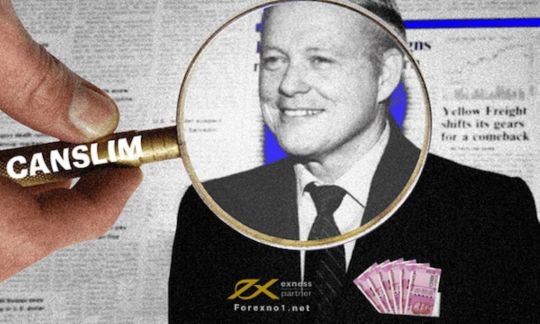
0 notes
Text

let's talk about another well-known anne carson set of three lines, shall we and by talk about i once again mean i am going to share with you a bunch of translations and then you can have a think for yourself and i will do my best to study microbiology
here they are in the original greek:

okay, actually, i want to share a bit more than three, here's the anne carson translation with a few extra lines

lets start with my own translations this time. i came up with three. (i did only translate the three lines bc frankly i don't have the time to do any of this just now)



not going to do a full breakdown of my translations this time but you are very welcome to explore the text for yourself in the original ancient greek with a very convenient word search tool here - it's lines 793-795. if you'd like a very basic breakdown of ancient greek grammar, i refer you back to an earlier post of mine - doesn't explain everything but might be a decent place to start anyway, here's some more translations:

George Theodoridis, 2010

Ian C. Johnston, 2010

Andrew Wilson, 1994

Euripides. The Complete Greek Drama, edited by Whitney J. Oates and Eugene O'Neill, Jr. in two volumes. 2. Orestes, translated by E. P. Coleridge. New York. Random House. 1938.


William Arrowsmith, 1958

John Peck and Frank Nisetich, 1995
#anne carson#not to me not if it's you#ancient greek#an oresteia#orestes#philology#web weaving#this isn't technically but close enough
32 notes
·
View notes
Text
Book Spotlight Steel Valley Jerry Madden #HistoricalFiction #SteelValley #ComingOfAge #BlogTour #TheCoffeePotBookClub @JerryMadden1948 @cathiedunn

BOOK SPOTLIGHT: STEEL VALLEY I am pleased to spotlight the book, Steel Valley, by Jerry Madden in The Coffee Pot Book Club Blog Tour held on February 22nd, 2024. Steel Valley: Coming of Age in the Ohio Valley in the 1960s is a Historical Fiction published by Potomac Publishing Company on January 20, 2023 (350 pages). Below are highlights of Steel Valley and Jerry Madden's author biography. Tour Schedule Page: https://thecoffeepotbookclub.blogspot.com/2024/01/blog-tour-steel-valley-by-jerry-madden.html HIGHLIGHTS: STEEL VALLEY Steel Valley: Coming of Age in the Ohio Valley in the 1960s By Jerry Madden Blurb: For readers of The World Played Chess by Robert Dugoni and Last Summer Boys by Bill Rivers Love is never easy...even in easier times, like the 1950s and 1960s in the Ohio Valley with the steel industry booming. Second-generation immigrant families were reaching for the American middle class. And Catholic schools — made feasible by selfless Catholic nuns — promised bigger lives for everyone, including Jack Clark and Laurie Carmine. As they spent years searching for their separate futures, though, they were also stumbling toward love just as their world came crashing down. Steel Valley depicts a story of love longed for, lost, and perhaps still within reach, just as our nation's mythic yesterday became our troubled today, our last summer of innocence. Buy Link: Universal Buy Link: https://books2read.com/u/3nGw5K AUTHOR BIO: JERRY MADDEN Jerry Madden grew up in the Upper Ohio Valley in the 1960s. He holds a B.A. from the College of Steubenville and law degrees from the University of Dayton School of Law and the Georgetown University Law Center. After law school, Jerry served as the sole law clerk to the Chief Justice of the Supreme Court of Ohio, C. William O'Neill. He served in the United States Marine Corps (R) between 1970 and 1976. Jerry has practiced law in Washington, D.C., since 1979, including fourteen years at the Department of Justice as a trial and appellate attorney. He is the principal of The Madden Law Group PLLC in Washington, D.C. He lives in Northern Virginia with his wife, Cyndi, a retired educator. They have two children, Kelsey and Jack, both of whom hold M.Ed. degrees. They have one grandchild, Jamie Maclennan. Author Links: Website: https://steelvalleymadden.com/ Twitter: https://twitter.com/JerryMadden1948 Amazon Author Page: https://www.amazon.com/stores/Jerry-Madden/author/B0BV19VM3F Goodreads: https://www.goodreads.com/book/show/199752995-steel-valley Instagram Handle: @thecoffeepotbookclub Bluesky Handle: @cathiedunn.bsky.social Read the full article
0 notes